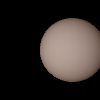ambient()#
Sets the ambient reflectance for shapes drawn to the screen.
Examples#

def setup():
py5.size(100, 100, py5.P3D)
py5.background(0)
py5.no_stroke()
py5.directional_light(153, 153, 153, .5, 0, -1)
py5.ambient_light(153, 102, 0)
py5.ambient(51, 26, 0)
py5.translate(70, 50, 0)
py5.sphere(30)
Description#
Sets the ambient reflectance for shapes drawn to the screen. This is combined with the ambient light component of the environment. The color components set through the parameters define the reflectance. For example in the default color mode, setting ambient(255, 127, 0), would cause all the red light to reflect and half of the green light to reflect. Use in combination with emissive(), specular(), and shininess() to set the material properties of shapes.
This method has additional color functionality that is not reflected in the method’s signatures. For example, you can pass the name of a color (e.g. “green”, “mediumpurple”, etc). Look at the online “All About Colors” Python Ecosystem Integration tutorial for more information.
Underlying Processing method: ambient
Signatures#
ambient(
gray: float, # number specifying value between white and black
/,
) -> None
ambient(
rgb: int, # any value of the color datatype
/,
) -> None
ambient(
v1: float, # red or hue value (depending on current color mode)
v2: float, # green or saturation value (depending on current color mode)
v3: float, # blue or brightness value (depending on current color mode)
/,
) -> None
Updated on December 25, 2023 16:36:33pm UTC
